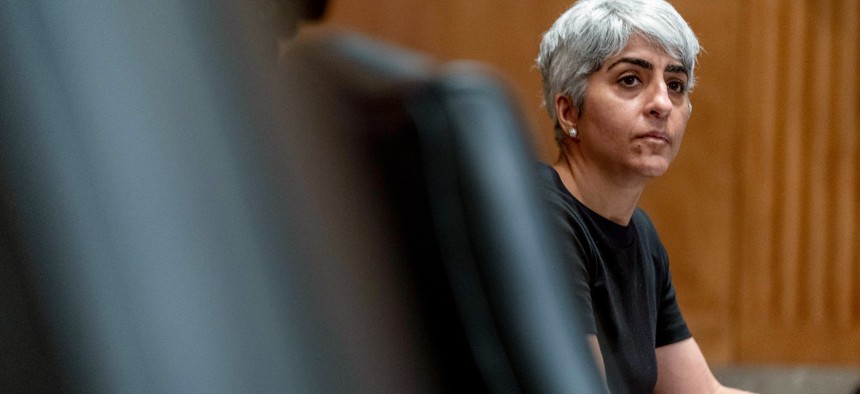
Kiran Ahuja said that the Office of Personnel Management has spent much of 2021 rebuilding its capacity. Andrew Harnik / AP
Ahuja: OPM Has Hired More than 300 as Part of Agency Rebuild
The director of the Office of Personnel Management said a recent report on how to reform the HR agency has “galvanized” its workforce in support of change.
Office of Personnel Management Director Kiran Ahuja said that her agency has spent much of 2021 rebuilding its capacity as it prepares an ambitious policy agenda aligned with the findings of a recent report aimed at reforming federal human capital management.
During an event hosted by the National Academy of Public Administration, which authored the congressionally mandated report on the future of OPM, Ahuja said her agency has hired more than 340 people this year in an effort to counteract recent attrition at the federal government’s HR agency and to prepare for an ambitious agenda focused on improving federal hiring, internships, pay and benefits and developing hybrid work environments across the government.
“We’re integrating your report’s findings through every aspect of our planning . . . our strategic plan and budget proposals are all incorporating the work and recommendations in the report,” she said. “Taken together, I think this really demonstrates a clear path for OPM to deliver on its charge and well into the future . . . And within OPM itself we are elevating the agency. In fiscal 2021 alone, OPM has onboarded more than 340 people, and we’re working very hard to ensure not only are we in good shape, but we’re in good shape to serve every agency and make sure they have the tools and support they need.”
Ahuja said OPM already is seeing renewed relevance in policymaking, citing her agency’s involvement as “co-leader” of the White House Safer Federal Workforce Task Force and the high priority given to federal human capital issues in the President’s Management Agenda. And she provided a laundry list of upcoming initiatives that the agency has been working on internally, including the return of the Presidential Rank Awards.
“The goal is not just to build a federal workforce for today’s challenges, it’s to create a foundation for a federal government that allows Americans to thrive for decades to come,” she said. “[An] additional effort OPM has taken on with increased focus has been work focused on low wage workers and unions. A part of that is not only trying to seeking top talent, but also wanting to make sure we continue to promote the federal government as a good paying job, providing competitive job packages and rewarding careers.”
Next year, Ahuja said observers can expect OPM to deliver on planned recommendations on how to ensure every federal employee makes at least $15 per hour, helping federal agencies develop strategic plans to improve diversity, equity, inclusion and accessibility, reform of federal internships and “iterative” improvements in both retirement claims and the Federal Employees Health Benefits Program.
“We’re going to continue to double down in areas like early career talent, hiring, pay and the future of work,” she said. “What you’ll start to see in 2022 is a refresh of the pathways program, really trying to reconnect and reinvigorate relationships with colleges, trade schools and other institutions . . . and we’re also exploring the feasibility of a central internship portal on USAJOBS, including third party programs . . . We’re also starting a hiring assessment line of business in partnership with [the Office of Management and Budget] to sponsor innovations in hiring and strengthening hiring assessments at agencies.”
The director stressed that in the short term, OPM will be focused on simple reforms that can produce immediate results, like better educating agencies on the various flexibilities in hiring and pay that are already at their disposal. Success on that front will clear the way for more transformative changes, Ahuja said.
“I realize that these are hard and complicated issues, and there are reasons for it in the sense of good intentions, the regulatory policies and how we think about competitive hiring,” she said. “There’s a lot of frustration in the process, but from myself and others there’s such positive energy to—again, this is not to say we can’t think pie in the sky—look at what’s right in front of us that we can fix and improve in real time . . . I think we’re mindful of the time we have and those short term successes provide us something to build on with some of the long-term systematic changes that we all also long for.”







